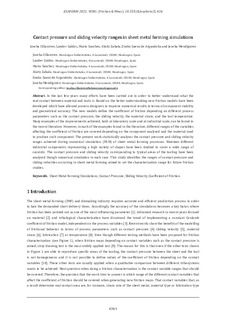
Título
Contact pressure and sliding velocity ranges in sheet metal forming simulationsAutor-a
Versión
Version publicada
Derechos
© 2021 The authorsAcceso
Acceso abiertoVersión del editor
https://doi.org/10.25518/esaform21.426Publicado en
ESAFORM Proceedings N. artículo 426, 2021Palabras clave
Sheet Metal Forming SimulationsContact Pressure
Sliding Velocity
Coefficient of Friction
Resumen
In the last few years many efforts have been carried out in order to better understand what the real contact between material and tools is. Based on the better understanding new friction models have b ... [+]
In the last few years many efforts have been carried out in order to better understand what the real contact between material and tools is. Based on the better understanding new friction models have been developed which have allowed process designers to improve numerical results in terms of component viability and geometrical accuracy. The new models define the coefficient of friction depending on different process parameters such as the contact pressure, the sliding velocity, the material strain, and the tool temperature. Many examples of the improvements achieved, both at laboratory scale and at industrial scale, can be found in the recent literature. However, in each of the examples found in the literature, different ranges of the variables affecting the coefficient of friction are covered depending on the component analysed and the material used to produce such component. The present work statistically analyses the contact pressure and sliding velocity ranges achieved during numerical simulation (FEM) of sheet metal forming processes. Nineteen different industrial components representing a high variety of shapes have been studied to cover a wide range of casuistic. The contact pressure and sliding velocity corresponding to typical areas of the tooling have been analysed though numerical simulation in each case. This study identifies the ranges of contact-pressure and sliding velocities occurring in sheet metal forming aimed to set the characterization range for future friction studies. [-]
Colecciones
- Congresos - Ingeniería [404]
El ítem tiene asociados los siguientes ficheros de licencia:





















